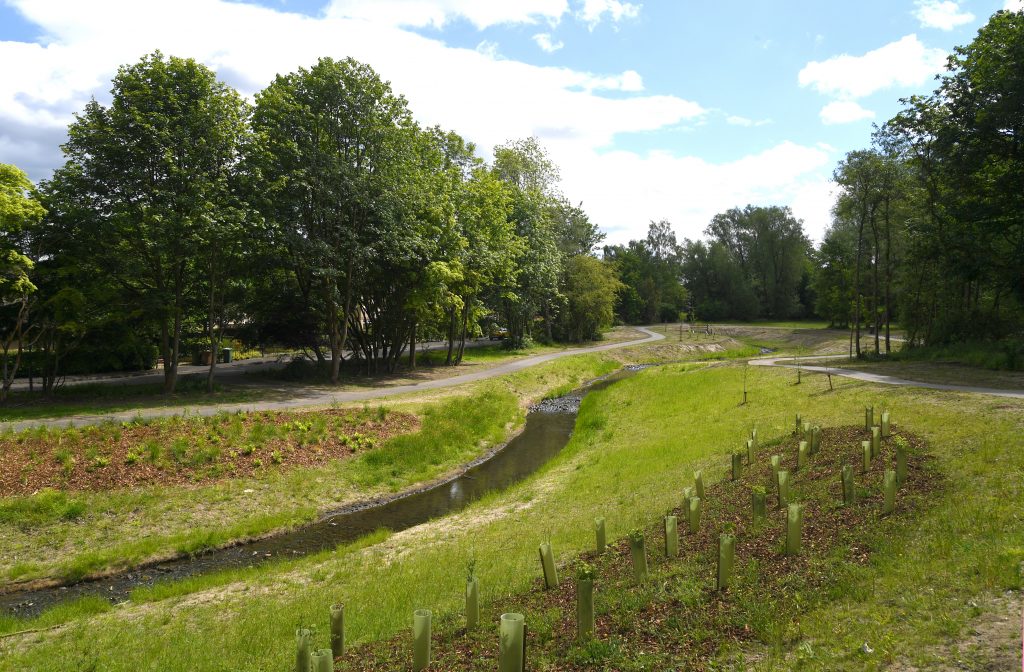Hidden Burn Brought Back to the Surface at Sandyhills Park

Concealed, after being culverted through Sandyhills Park in the 1950’s – work is now complete to uncover a section of Tollcross Burn and restore it to its original route as part of a major Glasgow City Deal project to reduce flood risk and build climate resilience.
The newly ‘daylighted’ burn which had been diverted underground to accommodate house building, now forms an appealing focal point within the park which will help alleviate flood risk during heavy rainfall events. Regeneration opportunities in the local area will also be stimulated as development limitations arising from previous drainage constraints have been taken away.
Poor quality trees were removed when work first started and have been compensated for with a robust and high-quality landscape design scheme that will stimulate biodiversity and encourage wildlife. The nature-based design also includes the introduction of standard and feature trees, woodland planting, shallow water planting and meadow planting – all of which suit the natural surroundings of Sandyhills Park and offer enhanced outdoor space for locals and visitors. The connectivity of the park has also been greatly improved, with the installation of a brand-new footbridge over the burn which links the park with residential properties close by.
Glasgow City Region City Deal (funded by both the UK and Scottish Governments) provided funding for the project at Sandyhills Park through the Metropolitan Glasgow Strategic Drainage Partnership (MGSDP); alongside the Scottish Environment Protection Agency (SEPA) through their Water Environment Fund, and Scottish Water.
Cllr Susan Aitken, Leader of Glasgow City Council and Chair of the Glasgow City Region City Deal Cabinet said: “This City Deal project which is testament to the power of partnership working, offers nature-based solutions to lessen the risk of localised flooding and unlock the area’s development potential. I’m delighted that Tollcross Burn can now be seen and enjoyed once again within this much improved, biodiverse and better-connected local park.”
John Kenny, Chief Officer at SEPA, said: “This marks a major milestone in the Sandyhills Park project and the realisation of a shared ambition to deliver environmental, social and economic benefits into the heart of Glasgow’s East End. Speaking as a Glasgow boy who played in this very burn with my brother when we were little, I know how significant it is for this area. Lots has been said over the past year about the need for a green recovery from COVID-19 – here we have evidence that our dear green place can play a role. As Scotland’s environmental regulator and strategic flood risk management authority, SEPA shares Scottish Government’s ambition to deliver sustainable blue-green cities of the future, and we’re proud to be delivering this project on its behalf in partnership with Glasgow City Council through the City Deal.”
UK Government Minister for Scotland Iain Stewart said: “After the past year, we’re all more aware of how important our outdoor public spaces are, so it’s great that visitors to Sandyhills Park are now able to fully enjoy the environmental benefits of the Tollcross Burn, including reduced flooding risk and a more bio-diverse and scenic area to spend time in. The UK Government is investing more than £1.5 billion into City Region and Growth Deals across Scotland, helping communities to build back better from the pandemic.”
Finance and Economy Secretary Kate Forbes said: “It’s great to see the work complete to uncover Tollcross Burn once more as part of the Glasgow City Region Deal, which will reduce future flood risk while increasing biodiversity and wildlife in Sandyhills Park, and also improve accessibility for local residents. The Scottish Government is a full partner in the Deal, contributing £500 million over 20 years. The investment is contributing to the region’s economic recovery by creating jobs and providing the commercial infrastructure to support and attract businesses to Glasgow and the surrounding areas. It also encourages active travel supporting walking and cycling infrastructure in the area.”
Through MGSDP City Deal investment of circa £45m, Glasgow is working with partners to deliver a programme of drainage schemes, targeting areas of the city where rainfall negatively impacts communities. The MGSDP is a partnership between public bodies and was founded in 2002 by Glasgow City Council, Scottish Water and SEPA, and has grown to include a wide range of local authorities, public and third sector bodies.
Both the UK and Scottish Governments are providing the Glasgow City Region local authorities with £500million each in grant funding for the Glasgow City Region City Deal.
Glasgow based contractor, RJ McLeod have delivered works on-site with AECOM working as design consultant, project manager and site supervisor.